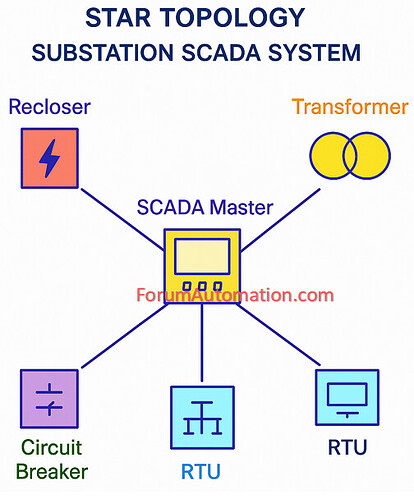Star Topology in Substation SCADA Systems
A star topology is a network design in which all devices (such as IEDs, RTUs, and HMIs) are connected to a single node (or) switch.
In substation SCADA systems, the central point is usually a network switch (or) server.
How does Star topology Works?
Each
- Intelligent Electronic Device (IED) (or)
- Remote Terminal Unit (RTU)
connects to the central switch.
This central point serves as the communication link between the SCADA master (or substation server) and all other devices.
This hub handles all data (signals, measurement & control commands).
Advantages of Star Topology for SCADA
- It is easier to control & monitor the system from one location.
- Fault isolation means that if one connection fails, the rest of network continues to operate.
- Faults are simple to identify and isolate.
- New devices may be added without disrupting the current system.
Disadvantages of Star Topology for SCADA
- If the central switch (or) hub fails, the entire system may shut down.
- Requires more wiring than alternative topologies such as bus or ring.
- In a digital substation, IEDs from different bays (e.g., feeders, transformers, breakers) link to a redundant Ethernet switch in a star topology.
- That switch serves as the communication link between the SCADA system (or) HMI and all other devices.
- Protocols such as IEC 61850, MMS & GOOSE can be utilized over this topology.
You can also follow us on AutomationForum.co, Facebook and Linkedin to receive daily Instrumentation updates.
You can also follow us on ForumElectrical.com , Facebook and Linkedin to receive daily Electrical updates.
